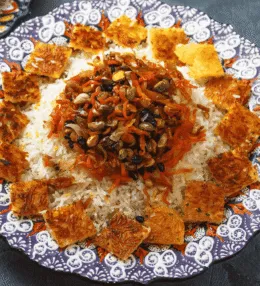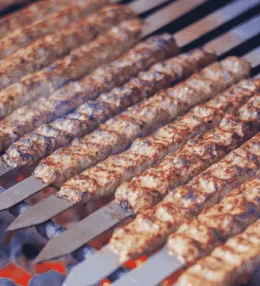
- View
Table of Contents
ToggleKwati is a traditional Nepali stew that brings warmth and nourishment in one earthy, aromatic bowl. Made with nine varieties of sprouted beans, it is celebrated during Janai Purnima, a festival marking renewal and protection. This hearty dish reflects Nepal’s deep respect for food as both sustenance and ritual.
Rich in flavour and packed with protein, Kwati is more than just a seasonal meal. It is a dish steeped in community, custom and balance. When the weather begins to cool, families across Nepal turn to this comfort stew, simmered slowly and seasoned with a medley of spices that define the region’s cuisine.
Want to dive deeper into Nepalese Cuisine? Don’t miss our post on 15 Traditional Nepalese Foods to Try
What Is Kwati?
Kwati is a mixed bean stew prepared using a carefully selected mix of legumes that have been soaked and sprouted. The process of sprouting, which takes a few days, not only softens the beans but also boosts their nutritional value, making the stew highly nourishing.
The stew is traditionally enjoyed hot and is believed to help restore energy and promote good health. In many homes, Kwati is also considered a cleansing dish, ideal for breaking routine diets and giving the digestive system a boost during the seasonal shift from monsoon to autumn.
Ingredients and Taste
The base of Kwati typically includes sprouted black gram, green gram, chickpeas, soybeans, field peas and various types of lentils. The beans are first soaked, then sprouted over several days and finally simmered gently in a spiced broth.
Tempered with garlic, ginger, fenugreek and turmeric, the stew takes on a warm, slightly tangy flavour that deepens with each spoonful. Some variations use ghee to finish, adding a velvety richness, while others include jimbu, a local herb that brings a subtle onion like aroma.
Though filling, Kwati remains light on the palate. The variety of beans provides a satisfying bite, while the mild spices create a flavour that is layered but never overpowering. Served with rice or on its own, it feels both grounding and restorative.
A Taste of History
Kwati has its roots in the Newar community of the Kathmandu Valley, where it was first prepared as a ceremonial dish to mark Janai Purnima. Over time, it spread across Nepal’s diverse communities, each adding their own regional twist.
Historically, Janai Purnima was seen as a time of transition and spiritual renewal. Kwati, being rich in nutrients and easy to digest, was offered to help strengthen the body and purify the system during this sacred time. It became part of both religious observance and seasonal wellbeing.
Today, Kwati continues to hold a special place in Nepali households. Though modern versions may adapt the recipe slightly, the essence remains unchanged. It is still made with care, eaten slowly and shared with family. A small, nourishing ritual passed down with pride.
For anyone exploring Nepali cuisine, Kwati offers a glimpse into how food, tradition and health are deeply interwoven. It is humble yet symbolic, practical yet spiritual, and every spoonful tells a story of heritage, season and connection.
How to Make Nepali Kwati
Kwati is a hearty and nourishing stew made with a medley of sprouted beans, traditionally enjoyed during the festival of Janai Purnima in Nepal. Rich in protein and deep in flavour, this dish combines garlic, ginger, and a blend of spices to transform humble legumes into a comforting main. Expect a slightly spicy, earthy aroma as the stew simmers, and don’t rush the process, allowing the flavours to develop fully is key. See the recipe card at the bottom for printable directions
Ingredients
Sprouted Bean Mix (approximately 2 cups total):
- 2 tablespoons black gram (urad dal)
- 2 tablespoons mung beans
- 2 tablespoons red kidney beans
- 2 tablespoons chickpeas
- 2 tablespoons soybeans
- 2 tablespoons green peas
- 2 tablespoons field peas
- 2 tablespoons cowpeas
- 2 tablespoons black-eyed peas
For the stew:
- 2 tablespoons ghee or mustard oil
- 1 teaspoon fenugreek seeds (methi)
- 1 medium onion, finely chopped
- 1 tablespoon garlic, minced
- 1 tablespoon ginger, minced
- 2 medium tomatoes, chopped
- 1 teaspoon turmeric powder
- 1½ teaspoons cumin powder
- 1½ teaspoons coriander powder
- ½ teaspoon red chilli powder (optional)
- Salt to taste
- 1.2 litres water or vegetable stock
- 1 tablespoon chopped fresh coriander for garnish
Cooking Instruction
Step 1/9: Prepare and Sprout the Beans
Rinse all nine types of beans thoroughly and soak them together in water overnight. The next morning, drain and transfer them to a clean cloth or sprouting container. Keep in a warm place and rinse daily. Allow 2 to 3 days for proper sprouting before cooking.
Step 2/9: Sauté the Base Aromatics
Heat ghee or mustard oil in a heavy bottomed pot over medium heat. Add fenugreek seeds and allow them to darken slightly. Add chopped onions and sauté until golden, about 4 to 5 minutes. Stir occasionally for even colour.
Step 3/9: Add Garlic and Ginger
Add minced garlic and ginger to the pot. Cook for 1 to 2 minutes until fragrant. This step helps deepen the base flavour and balances the earthy taste of the sprouted beans.
Step 4/9: Cook Down the Tomatoes
Stir in the chopped tomatoes. Cook until they soften and break down into a thick paste, about 5 to 6 minutes. You can mash them lightly with a spoon to help them blend faster.
Step 5/9: Spice the Mixture
Sprinkle in turmeric, cumin, coriander, and optional red chilli powder. Cook the spices with the mixture for 1 minute, stirring to prevent burning. This toasting helps unlock deeper aromatic notes.
Step 6/9: Add the Sprouted Beans
Now add the sprouted beans to the pot. Stir well to coat the beans in the spiced tomato mixture. Let it cook for 2 to 3 minutes so the beans absorb the flavours before adding liquid.
Step 7/9: Simmer the Stew
Pour in water or vegetable stock. Bring the mixture to a boil, then reduce to a simmer. Cover and cook for 35 to 40 minutes, or until the beans are tender and the broth is rich. Stir occasionally to prevent sticking.
Step 8/9: Adjust Seasoning
Taste the stew and adjust the salt if needed. If it’s too thick, add a bit more hot water. If you prefer it thicker, remove the lid and simmer for another 5 to 10 minutes uncovered.
Final Step/9: Garnish and Serve
Ladle the Kwati into serving bowls and garnish with chopped fresh coriander. Serve hot with steamed rice or flatbread. A wedge of lemon on the side adds a welcome brightness that balances the earthy richness.
Cooking Tips for Perfect Kwati
- Use freshly sprouted beans for better texture and nutrition
- Don’t skip the fenugreek seeds; they add a unique Nepali character to the stew
- Ghee gives the stew authentic flavour, but mustard oil adds a traditional bite
- Let the beans simmer slowly to develop depth and avoid breaking them up
- If preparing ahead, allow the stew to rest and reheat gently to improve taste

Nepali Kwati (Mixed Bean Stew)
Ingredients
Sprouted Bean Mix (approximately 2 cups total):
- 2 tablespoons black gram urad dal
- 2 tablespoons mung beans
- 2 tablespoons red kidney beans
- 2 tablespoons chickpeas
- 2 tablespoons soybeans
- 2 tablespoons green peas
- 2 tablespoons field peas
- 2 tablespoons cowpeas
- 2 tablespoons black-eyed peas
For the stew:
- 2 tablespoons ghee or mustard oil
- 1 teaspoon fenugreek seeds methi
- 1 medium onion finely chopped
- 1 tablespoon garlic minced
- 1 tablespoon ginger minced
- 2 medium tomatoes chopped
- 1 teaspoon turmeric powder
- 1½ teaspoons cumin powder
- 1½ teaspoons coriander powder
- ½ teaspoon red chilli powder optional
- Salt to taste
- 1.2 litres water or vegetable stock
- 1 tablespoon chopped fresh coriander for garnish
Instructions
- Rinse all nine types of beans thoroughly and soak them together in water overnight. The next morning, drain and transfer them to a clean cloth or sprouting container. Keep in a warm place and rinse daily. Allow 2 to 3 days for proper sprouting before cooking.
- Heat ghee or mustard oil in a heavy bottomed pot over medium heat. Add fenugreek seeds and allow them to darken slightly. Add chopped onions and sauté until golden, about 4 to 5 minutes. Stir occasionally for even colour.
- Add minced garlic and ginger to the pot. Cook for 1 to 2 minutes until fragrant. This step helps deepen the base flavour and balances the earthy taste of the sprouted beans.
- Stir in the chopped tomatoes. Cook until they soften and break down into a thick paste, about 5 to 6 minutes. You can mash them lightly with a spoon to help them blend faster.
- Sprinkle in turmeric, cumin, coriander, and optional red chilli powder. Cook the spices with the mixture for 1 minute, stirring to prevent burning. This toasting helps unlock deeper aromatic notes.
- Now add the sprouted beans to the pot. Stir well to coat the beans in the spiced tomato mixture. Let it cook for 2 to 3 minutes so the beans absorb the flavours before adding liquid.
- Pour in water or vegetable stock. Bring the mixture to a boil, then reduce to a simmer. Cover and cook for 35 to 40 minutes, or until the beans are tender and the broth is rich. Stir occasionally to prevent sticking.
- Taste the stew and adjust the salt if needed. If it’s too thick, add a bit more hot water. If you prefer it thicker, remove the lid and simmer for another 5 to 10 minutes uncovered.
- Ladle the Kwati into serving bowls and garnish with chopped fresh coriander. Serve hot with steamed rice or flatbread. A wedge of lemon on the side adds a welcome brightness that balances the earthy richness.
Nutrition
You May Also Like







Leave a Review